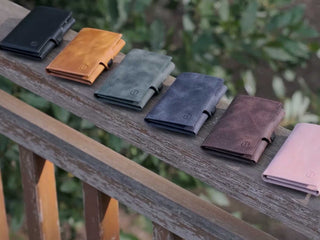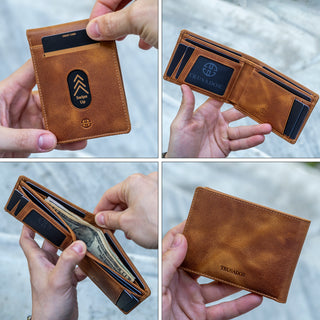What is a leather wallet?
A leather wallet is a small, portable case designed to hold money, credit cards, and other personal items. It is typically made from animal hide, specifically leather, which is known for its durability and longevity.
How are leather wallets made?
Leather wallets go through a meticulous manufacturing process to ensure their quality and durability. Here are the key steps involved:
Step 1: Leather selection
The first step in making a leather wallet is selecting the right type of leather. Different types of leather, such as full-grain, top-grain, and genuine leather, have distinct characteristics and qualities. The choice of leather depends on factors like durability, texture, and appearance.

Step 2: Cutting and shaping
Once the leather is selected, it is cut into the desired shape and size for the wallet. Skilled craftsmen use precise measurements and cutting tools to ensure accuracy and consistency.
Step 3: Stitching
The cut leather pieces are then stitched together using strong nylon or polyester thread. This stitching not only holds the wallet together but also adds to its aesthetic appeal. Skilled artisans use various stitching techniques, such as saddle stitching, to ensure durability.

Step 4: Edge finishing
After stitching, the edges of the wallet are carefully finished to give them a smooth and polished look. This process involves trimming any excess leather and burnishing the edges to create a neat and refined appearance.
Step 5: Assembly
Once the individual components are prepared, they are assembled to create the final wallet. This includes attaching the card slots, coin pouch, and any additional compartments or features.
Step 6: Quality control
Before the wallets are ready for sale, they undergo rigorous quality control checks. Each wallet is inspected for stitching quality, alignment, and overall craftsmanship. Any imperfections are addressed to ensure that only the highest quality wallets reach the market.
What types of leathers are used in processing?
Several types of leather are commonly used in the production of wallets. Here are some of the most popular ones:
1. Full-grain leather
Full-grain leather is the highest quality and most durable type of leather. It is made from the top layer of the animal hide and retains the natural grain and imperfections, giving it a unique and authentic appearance.
2. Top-grain leather
Top-grain leather is slightly lower in quality compared to full-grain leather. It is also made from the top layer of the hide but undergoes additional processing to remove imperfections. Top-grain leather is known for its smooth and uniform surface.
3. Genuine leather
Genuine leather is made from the lower layers of the hide. It is still real leather but is considered lower in quality compared to full-grain and top-grain leather. Genuine leather wallets are more affordable but may not be as durable as those made from higher-quality leathers.
4. Exotic leathers
In addition to the traditional leathers mentioned above, some wallets are made from exotic leathers such as alligator, crocodile, or ostrich. These leathers are highly sought after for their unique textures and patterns.
Conclusion
Leather wallets are crafted with precision and care, using various types of leathers to cater to different preferences and budgets. Whether you prefer the rugged authenticity of full-grain leather or the refined elegance of top-grain leather, there is a leather wallet out there to suit your style and needs.
FAQ
Q: How do I care for a leather wallet?
A: To keep your leather wallet in good condition, avoid exposing it to excessive moisture or direct sunlight. Regularly clean it with a soft, damp cloth and apply a leather conditioner to maintain its suppleness.
Q: Are leather wallets waterproof?
A: While leather has some natural water resistance, it is not completely waterproof. It is advisable to keep your leather wallet away from water to prevent damage.
Q: Can I personalize my leather wallet?
A: Many leather wallet manufacturers offer personalization options, such as embossing initials or adding custom designs. Check with the brand or retailer for customization services.
Leather wallets have been a popular accessory for centuries. They are not only functional but also add a touch of sophistication to any outfit. In this blog post, we will explore how leather wallets are made and the different types of leather used in their production.
How are leather wallets made?
The process of making a leather wallet involves several steps, starting from the selection of high-quality leather to the final stitching. Here is a brief overview of the process:
- Leather selection: The first step in making a leather wallet is selecting the right type of leather. Different types of leather have different characteristics and qualities, so it is important to choose the one that best suits the desired style and durability of the wallet.
- Cutting: Once the leather is selected, it is cut into the desired shape and size for the wallet. This is usually done using a template or pattern.
- Edge finishing: The edges of the leather pieces are then smoothed and finished to give them a polished look.
- Assembly: The different parts of the wallet, such as the card slots, bill compartment, and coin pocket, are then assembled and stitched together.
- Final touches: The final touches, such as adding a logo or embossing the leather, are done to give the wallet a unique and personalized touch.
- Quality control: Before the wallets are packaged and ready for sale, they undergo a thorough quality control process to ensure that they meet the highest standards of craftsmanship and durability.
Types of leather used in wallet production
There are several types of leather used in the production of wallets. Each type has its own unique characteristics and qualities. Here are some of the most common types:
1. Full-grain leather
Full-grain leather is the highest quality leather available. It is made from the top layer of the hide and retains the natural grain and imperfections of the animal's skin. This type of leather is known for its durability, strength, and natural beauty. It develops a rich patina over time, making it even more attractive.
2. Top-grain leather
Top-grain leather is the second-highest quality leather. It is also made from the top layer of the hide but is sanded and buffed to remove any imperfections. This gives the leather a more uniform appearance and a slightly smoother texture compared to full-grain leather. Top-grain leather is still durable and retains some of the natural characteristics of the animal's skin.
3. Genuine leather
Genuine leather is made from the lower layers of the hide that are split off from the top grain. It is then processed and finished to give it a smooth and uniform appearance. While genuine leather is not as high quality as full-grain or top-grain leather, it is still a popular choice for wallets due to its affordability and decent durability.
4. Synthetic leather
Synthetic leather, also known as faux leather or vegan leather, is not made from animal hides. Instead, it is made from synthetic materials such as polyurethane (PU) or polyvinyl chloride (PVC). Synthetic leather can mimic the look and feel of real leather, but it is generally less durable and has a shorter lifespan.
Quality of the different leather types
The quality of leather used in wallets can vary depending on the type and the specific tanning and finishing processes used. Full-grain leather is considered the highest quality due to its natural characteristics and durability. Top-grain leather is also of high quality but may have a slightly smoother appearance. Genuine leather is a more affordable option but may not be as durable as full-grain or top-grain leather. Synthetic leather, while not as durable, offers a cruelty-free alternative for those who prefer not to use animal products.
Frequently Asked Questions (FAQ)
Q: How do I care for a leather wallet?
A: To care for a leather wallet, it is recommended to keep it away from direct sunlight and moisture. Regularly clean it with a soft cloth and apply a leather conditioner to keep it moisturized and prevent cracking.
Q: How long does a leather wallet typically last?
A: The lifespan of a leather wallet depends on various factors such as the quality of the leather, how well it is cared for, and the frequency of use. A well-made leather wallet can last for several years or even decades with proper care.
In conclusion, leather wallets are made through a meticulous process that involves selecting high-quality leather and skilled craftsmanship. The different types of leather used, such as full-grain, top-grain, genuine, and synthetic leather, offer various options in terms of quality, durability, and price. Whether you prefer the natural beauty of full-grain leather or the affordability of genuine leather, a well-made leather wallet is a timeless accessory that will last for years to come.








